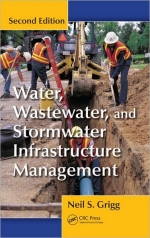Tab Article
Urban water services are building blocks for healthy cities, and they require complex and expensive infrastructure systems. Most of the infrastructure is out of sight and tends to be taken for granted, but an infrastructure financing crisis looms in the United States because the systems are aging and falling behind on maintenance. A road map for public works and utility professionals, Water, Wastewater, and Stormwater Infrastructure Management, Second Edition provides clear and practical guidance for life-cycle management of water infrastructure systems.
Grounded in solid engineering and business principles, the book explains how to plan, budget, design, construct, and manage the physical infrastructure of urban water systems. It blends knowledge from management fields such as facilities, finance, and maintenance with information about the unique technical attributes of water, wastewater, and stormwater systems.
- Addresses how to make a business case for infrastructure funding
- Demonstrates how to apply up-to-date methods for capital improvement planning and budgeting
- Outlines the latest developments in infrastructure asset management
- Identifies cutting-edge developments in information technology applied to infrastructure management
- Presents a realistic view of how risk management is applied to urban water infrastructure settings
- Explains the latest maintenance and operations methods for water, wastewater, and stormwater systems
The author describes current thinking on best management practices and topics such as asset management, vulnerability assessment, and total quality management of infrastructure systems. Expanded and updated throughout, this second edition reflects the considerable advances that have occurred in infrastructure management over the past ten years. Useful as a reference and a professional development guide, this unique book offers tools to help you lower costs and mitigate the rate shocks associated with managing infrastructure for growth, deterioration, and regulatory requirements.
What’s New in This Edition
- The latest infrastructure management and maintenance technologies
- Information on the inventories of systems and the configuration of infrastructure
- New design and construction methods such as building information modeling (BIM)
- New approaches to rate setting, accounting methods, and cost accounting to help you assess the full cost of infrastructure
- Advances in SCADA systems
- Expanded coverage of risk management and disaster preparedness
- Material on the use of GIS in water and sewer management
- New laws related to infrastructure, including the U.S. EPA’s efforts to develop a distribution system rule


